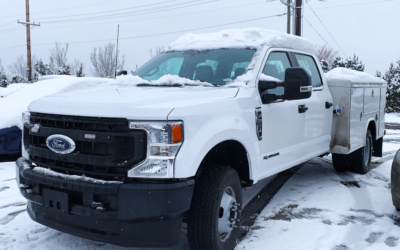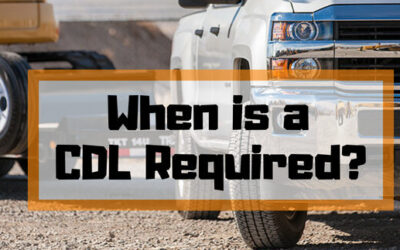6 Signs of Faulty Brakes
The fleet industry depends quite heavily on ensuring fleet safety and providing dependable and safe service. Faulty brakes that work sporadically or inefficiently can get in the way of that by increasing the chances of vehicular collisions. In truth, when it comes to accidents, brake-related problems are a pretty common cause.
According to a National Highway Traffic Safety Administration survey that was released in early 2015, a whopping 10,000 of the vehicle-related critical reasons behind car accidents were due to faulty brakes between 2005 and 2007. That is about 22% of collisions that are caused by a vehicle-related issue.
When you take these stats and look at them from the perspective of fleet safety, they will reflect that faulty brakes need to be addressed to ensure the safety of the drivers, cargo, and passengers. Drivers and fleet managers need to ensure that no vehicle in their fleet goes out on a job with faulty brakes.
With that said, even though annual inspections are a mandatory part of ensuring the safety of everyone involved, fleet drivers are the ones who need to be taught to spot the signs of faulty brakes. This is because before a vehicle’s brakes fail to work, they give some clear signs of being overworked or of faults that need to be fixed.
In fact, if you just know what to look for, then your vehicle’s brakes will give you the indications that you will need to get them repaired. Once you know that there’s a potential problem with the brakes, you can get them repaired right away. This will go a long way in ensuring fleet safety.
Here are the signs of faulty brakes that all fleet drivers should know about:
Noise
If you hear a metallic high-pitched squeal when your vehicle is in motion and it stops when you put the brakes on, then there might be something wrong with the brakes. Brake pads are made of steel and make this screeching sound when they start contracting the brake rotor. When you hear the sound, it means the pads are worn out and you need to replace them before your rotor is damaged.
Similarly, a grinding sound when you apply the brakes is indicative of a number of things. The noise may occur after rock or gravel has been caught in the caliper unit or if you have gone too long without servicing the brakes. In the latter situation, the noise indicates that the brake pads have worn out and the sound is of metal on metal.
Grinding is also indicative of a lack of lubrication in cars with rear drum brakes. It happens when the brake shoe scrapes on the metal contact points, such as the backing plate because of rust. If you hear any of these sounds coming from your vehicle, get your brakes serviced and repaired immediately to avoid brake failure.
Car Pulling to One Side
If your vehicle pulls to one side when you apply the brake, then there’s an issue with the brake. The vehicle pulls to one side when the brake hose has gone bad or there’s an issue with the caliper. One brake caliper might be applying more pressure during braking, which would result in unbalanced braking and compromise fleet safety.
Low Pedal
If you notice a lack of resistance in the brake pedal and if it feels softer and sinks to the floor mat upon putting pressure, then get your brake serviced right away. It’s a sign that there is moisture or air in the braking system or there’s an issue with the master cylinder. With power brakes, the pedal should stop at least 1 ½ inches from the floor. As for manual brakes, the brake pedal should stop at least 3 inches from the floor of your vehicle.
Hard-to-Press Pedal
If your brakes are delayed or don’t stop your vehicle as quickly as they are supposed to, then they might be failing. Similarly, if you have to apply extreme pressure to the pedal before the brake engages, get your brakes checked.
Vibration
If the steering wheel, brake pedal, or any other part of the car shakes or vibrates upon applying the brakes, then this might be a sign that the brakes are defective or broken. It might be that the rotors are uneven.
Brake rotors are large discs place inside the wheels of the vehicle. When you press down on the brake pedal, the brake pads press the rotors, slowing them down. Your vehicle slows down too. You want the rotors to be completely even in thickness and smooth to ensure fleet safety.
Warning Light
If the brake lights (one of the yellow or red brake display indicators) on your vehicle’s dashboard light up, then make sure to get your vehicle inspected. It might be that your vehicle’s smart electronics are alerting you of an issue. However, an engaged parking brake could also prompt the indicator to turn on. Make sure to release it to confirm that’s not the case.
The Bottom Line
Fleet safety is an important element that helps fleet businesses maintain a steady standing in their industry and earn the trust of their drivers and clients alike. This is why fleet companies must teach their drivers how to identify the signs of brake failure. Common signs include vibration in the brake pedal, warning brake lights, delayed braking, the vehicle pulling to one side, and various grinding and high pitched noises coming from the vehicle. If drivers are mindful of these signs, they will be able to tackle faulty brakes before the matter gets out of their hands and results in an accident.
Source:
https://www.automotive-fleet.com/351153/video-tip-how-to-spot-the-signs-of-faulty-brakes






